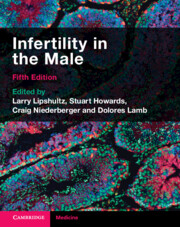Book contents
- Infertility in the Male
- Infertility in the Male
- Copyright page
- Contents
- Contributors
- Foreword
- Abbreviations
- Introduction
- Section 1 Scientific Foundations of Male Infertility
- Section 2 Clinical Evaluation of the Infertile Male
- Chapter 7 Infertility as a Metric of Men’s Health
- Chapter 8 Office Evaluation of the Subfertile Male
- Chapter 9 Evaluation of the Infertile Male’s Partner
- Chapter 10 Imaging the Male Reproductive System
- Chapter 11 Effects of Environmental Chemicals on Male Reproduction
- Chapter 12 Endocrine Causes of Male Infertility – Diagnosis and Treatment
- Chapter 13 Spermatogenesis – Diagnosis of Normal and Abnormal States
- Chapter 14 Inheritance and Male Fertility
- Chapter 15 The Varicocele – Approaches to Diagnosis and Management
- Chapter 16 Infection, Inflammation, and Immunological Causes of Male Infertility
- Section 3 Laboratory Diagnosis of Male Infertility
- Section 4 Treatment of Male Infertility
- Section 5 Health Care Systems and Culture
- Index
- References
Chapter 16 - Infection, Inflammation, and Immunological Causes of Male Infertility
from Section 2 - Clinical Evaluation of the Infertile Male
Published online by Cambridge University Press: 08 July 2023
- Infertility in the Male
- Infertility in the Male
- Copyright page
- Contents
- Contributors
- Foreword
- Abbreviations
- Introduction
- Section 1 Scientific Foundations of Male Infertility
- Section 2 Clinical Evaluation of the Infertile Male
- Chapter 7 Infertility as a Metric of Men’s Health
- Chapter 8 Office Evaluation of the Subfertile Male
- Chapter 9 Evaluation of the Infertile Male’s Partner
- Chapter 10 Imaging the Male Reproductive System
- Chapter 11 Effects of Environmental Chemicals on Male Reproduction
- Chapter 12 Endocrine Causes of Male Infertility – Diagnosis and Treatment
- Chapter 13 Spermatogenesis – Diagnosis of Normal and Abnormal States
- Chapter 14 Inheritance and Male Fertility
- Chapter 15 The Varicocele – Approaches to Diagnosis and Management
- Chapter 16 Infection, Inflammation, and Immunological Causes of Male Infertility
- Section 3 Laboratory Diagnosis of Male Infertility
- Section 4 Treatment of Male Infertility
- Section 5 Health Care Systems and Culture
- Index
- References
Summary
Infection and inflammation of the male reproductive tract are complex clinical conditions that can impact reproductive potential through a variety of pathophysiologic mechanisms. In this chapter, we discuss sites of genitourinary (GU) tract infections, infectious organisms, and the numerous ways in which leukocytes may impair male reproduction. Clinically, these processes most likely manifest as leukocytospermia and bacteriospermia.
- Type
- Chapter
- Information
- Infertility in the Male , pp. 277 - 328Publisher: Cambridge University PressPrint publication year: 2023



